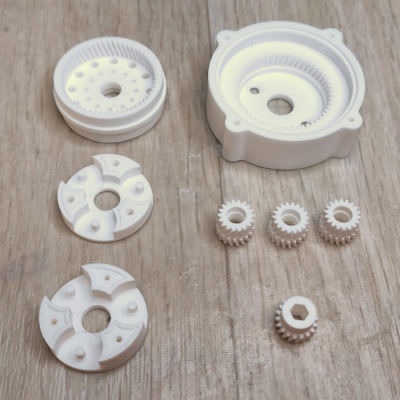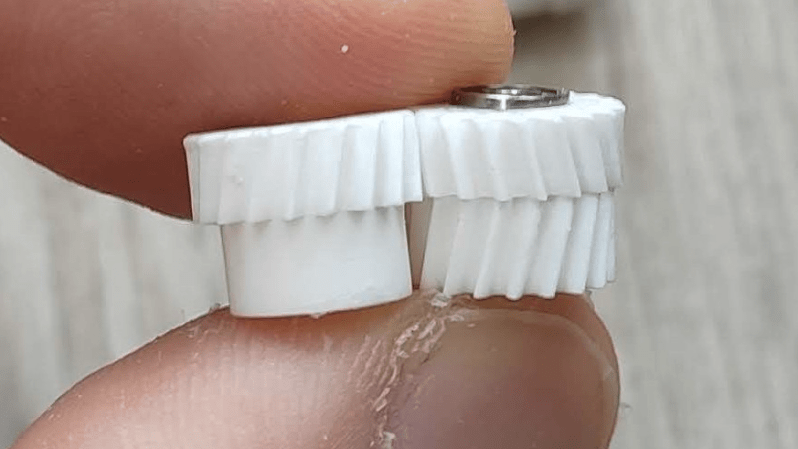There are plenty of resins advertised as being suitable for functional applications and parts, but which is best and for what purpose?
 According to [Jan Mrázek], if one is printing gears, then they are definitely not all the same. He recently got fantastic results with Siraya Tech Fast Mecha, a composite resin that contains a filler to improve its properties, and he has plenty of pictures and data to share.
According to [Jan Mrázek], if one is printing gears, then they are definitely not all the same. He recently got fantastic results with Siraya Tech Fast Mecha, a composite resin that contains a filler to improve its properties, and he has plenty of pictures and data to share.
[Jan] has identified some key features that are important for functional parts like gears. Dimensional accuracy is important, there should be low surface friction on mating surfaces, and the printed objects should be durable. Of course, nothing beats a good real-world test. [Jan] puts the resin to work with his favorite method: printing out a 1:85 compound planetary gearbox, and testing it to failure.
The results? The composite resin performed admirably, and somewhat to his surprise, the teeth on the little gears showed no signs of wear. We recommend checking out the results on his page. [Jan] has used the same process to test many different materials, and it’s always updated with all tests he has done to date.
Whether it’s working out all that can go wrong, or making flexible build plates before they were cool, We really admire [Jan Mrázek]’s commitment to getting the most out of 3D printing with resin.

















If you can learn how to make silicone molds and cast copies of your 3D printed parts, then you do not necessarily need to limit yourself to resins that are printable. Remember, 3D printing originated as a form of rapid prototyping, rather than using the print as a finished product. And still for many applications, the 3D print is only used as a master.
While it is nice to see that printable materials are growing, there are some materials you can’t print. But if you have molds you can cast the part in stronger materials like epoxy putty, metal clay, or even JB weld. With the right mold material, you can also make molds suitable for real metal casting. And finally, casting copies is always faster and more scalable than printing every piece, every time.
I already do polyurethane casting using silicone molds: https://twitter.com/yaqwsx_cz/status/1386575816222445575?t=awPVkz6VZMxO5tVLzFKTIQ&s=19
There’s several posts on making (not only) silicone molds via resin printing on my blog. There’s also a comparison of printed gerboxes with cast one available at: https://blog.honzamrazek.cz/2022/02/overview-of-practical-resin-properties/
I’m not sure if it means anything to anyone who scoffs at 3D printing, but here goes nothing…. I’m an aerospace designer, machinist, and 3D printer by trade. I have 3D printers, a CNC mill, and injection mold machine in my garage. And get this… i make a living 3d printing end use parts. My customers are not stupid. They know aluminum or steel parts would be better. They know injection molding, bleh bleh bleh would be better. BUT, 3D printing enables me to design something on Friday and have it for sale on Monday at a great price and with very little up front investment. In a niche industry, if I can 3d print an end-use product that satisfies my customers I will. I will be more agile than the mass-producer and can get my customers what they’re looking for before those who are using traditional manufacturing methods. There’s a place for 3D printing outside of prototyping. Just my two cents. Hope it helps someone who is giving in to the mob of doubters. Keep up the good work and keep pushing the bounds of 3D printing!!!
I use 3D printed parts all the time straight from the printer, I wasn’t suggesting that you can’t find use for plastic and resin parts. But printing plastic parts for use in plastic applications was not what the article was about, we’re talking about adding strength for cases where plastic will not do. And the stronger you want the finished product, the more expensive the printers and print mediums.
I build RC cars and specifically do have need for metal and carbon fiber parts in my applications. Since metal printers are around $100K USD and I don’t have a business selling my plastic prints, it makes more sense to make a mold from what I can print cheaply in plastic. For the small number of one-off parts I will need, trying to print everything would just not be cost effective. And RC parts break all the time, so it’s nice to be able to cast copies within hours rather than waiting a day and a half for a printer.
Your mileage may vary, but personally I like to have fun, and plastic gears are generally the antithesis of fun in the RC world.
See decade old Internet classic: “Guerrilla guide to CNC and resin casting”
useing plastic for a gear is like putting a tomato
seed in a plastic pot and calling it a farm
gearesque
gearish
gear like
how about someone print a plastic gear,like the ones
found in automatic transmissions for cars,that are used
to determine the shift point for top GEAR,and then go for a drive,the factory ones look to be nylon and good
for 160000 km and stupid cheap to make and buy
Username checks out.
There are tons of applications where 3D-printed plastic gears are more than perfectly fine; a blanket-statement of “3D-printed gears bad!!oneoneeleven” is both ignorant and elitist.
Or just plain wrong. I have tons of plastic gears in eyesight right now, doing exactly what they’re designed to do.
Still, I wouldn’t use one for the main steering pinion on my car.